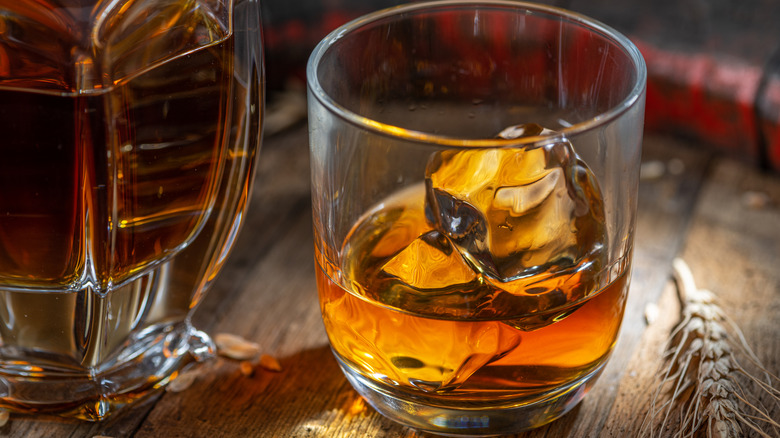Why Bourbon Lovers Should Be Wary Of Special Wood-Finished Barrels
It's not just any old distiller who can claim to be making bourbon. U.S. law is pretty strict on the matter: bourbon must be made in America, the mash bill must be at least 51% corn, and it must be aged in new, charred oak barrels for at least two years. But within this, there's room for flexibility. American distillers have caught wind of the Scottish tradition of finishing whisky, which is when the liquor is transferred to a second barrel after its initial aging process to develop complexity of flavor.
The second barrels have usually held a different alcohol, such as wine, beer, or rum, meaning the bourbon absorbs some of the unique aromas of the initial drink. But it's a controversial practice: In 1999, Booker Noe became the first major American distiller to drop a cask-finished bourbon. Distiller's Masterpiece was aged in cognac barrels, but its hefty price-tag of $250 turned away cost-conscious consumers.
Today, the situation's no different. Cask finishes are rare, exclusive, and expensive, often elevated by intricate labeling and premium packaging. In 2024, the average limited-edition bourbon cost $200, but inflation stresses and health concerns means Americans are less likely to cash out on expensive spirits, instead going for cheaper cans or low-alcohol options. Then there's the case of amburana – the wood traditionally used to barrel age cachaça in South America — that enchanted American producers a few years back for its cinnamon-sweet scent. However, amburana barrels were much more expensive than oak, driving up prices, and some thought the perfumed aromas overwhelmed the whiskey. And then, there were those who aged the whiskey in amburana staves or chips to cut costs — though this offended some traditionalists.
What's the good side?
So, wood-finished barrels and bourbon aren't a simple love affair, and whiskey drinkers should stay vigilant to complications and concerns. However, there's a reason people fall in love with it. Special wood-finished barrels can help craft the whiskey's flavor profile, adding nuance and depth. Sherry casks create sweet, fruity notes, for instance, whereas rum adds elements of tropical fruit, spice, and sweetness. On the other hand, wine also gives tannins and acidity, whereas cognac helps with a smooth, silky finish.
Prime examples include Blackened's flagship bourbon, which is finished in brandy casks, instilling the liquid with notes of apricot, honey, and caramel. The popular Angel Envy, a small-batch whiskey, is finished in ruby port wine casks. There's also Blood Oath, a blended whiskey with a variety of cask finishings — such as in cabernet sauvignon barrels, which add layers of dark fruit, stone fruit, and coffee to the alcohol.
The Scots have been doing it for ages, so try out the sherry-aged version of the must-know whiskey brand Johnnie Walker, to get a taste of where it all began. Wood-finished bourbons may come with a higher price tag, but the unique depth of flavor they offer is unmatched. Whether you'll love it or leave it, you won't know until you take that first sip.

